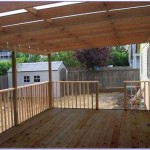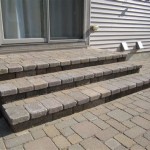How To Install a Pergola on a Concrete Patio
Installing a pergola on a concrete patio can transform an outdoor space, offering shade, visual appeal, and an enhanced area for relaxation and entertainment. While a pergola can be erected on various surfaces, a concrete patio provides a stable and level foundation, simplifying the installation process. This article outlines the essential steps involved in successfully installing a pergola on a concrete patio, ensuring a secure and aesthetically pleasing outcome. The project requires careful planning, precise execution, and adherence to safety guidelines.
Before commencing the installation, a thorough assessment of the patio and pergola kit is crucial. Determine the desired location of the pergola, taking into account sun exposure, prevailing winds, and proximity to existing structures. Verify that the concrete patio is structurally sound and capable of supporting the weight of the pergola. Inspect the pergola kit to ensure all components are present and undamaged. Familiarize yourself with the manufacturer's instructions, as specific details may vary depending on the pergola design and materials.
Ensuring proper permits are obtained is paramount. Local building codes often require permits for structures like pergolas, particularly if they surpass a certain size or height. Contact the local building department to inquire about specific requirements and obtain the necessary approvals prior to starting the installation process. Failure to comply with building codes can result in fines or the removal of the structure.
Planning and Preparation
The planning phase is the foundation of a successful pergola installation. Accurate measurements, thoughtful design considerations, and meticulous preparation of the site are essential for a professional result.
First, determine the exact placement of the pergola posts on the concrete patio. Mark the locations clearly, ensuring they are evenly spaced and aligned according to the pergola's design. Use a measuring tape, level, and square to achieve precise placement. Consider the overall aesthetic of the patio and how the pergola will integrate with existing landscaping and furniture. Avoid placing posts in areas that may interfere with foot traffic or obstruct access to utilities.
Consider the aesthetic aspects of the installation. The style of the pergola should complement the existing architecture of the house and the overall design of the patio. Pergolas are available in a variety of materials, including wood, vinyl, and aluminum. Wood provides a natural and classic look, while vinyl offers low maintenance and durability. Aluminum is lightweight and resistant to corrosion. Consider the long-term maintenance requirements and budget when selecting the pergola material.
Once the location of the posts is determined, prepare the concrete surface for anchoring. This typically involves cleaning the area thoroughly to remove any dirt, debris, or stains. Use a pressure washer or scrub brush with a suitable cleaning solution to ensure the concrete is clean and free of any contaminants that could interfere with the adhesion of anchors.
Assess the existing concrete to verify its suitability for anchoring the pergola posts. Older or damaged concrete may require patching or repair before installation. If the concrete is cracked or crumbling, consult with a concrete specialist to determine the best course of action. It is essential to have a solid and stable base to securely anchor the pergola posts.
Anchoring the Pergola Posts
Securing the pergola posts to the concrete patio is a critical step in the installation process. The method used to anchor the posts will depend on the design of the pergola, the type of concrete, and the local building codes. Several anchoring options are available, each with its own advantages and disadvantages.
One common method involves using anchor bolts that are embedded into the concrete. This method provides a strong and secure connection, particularly for larger pergolas. To install anchor bolts, drill holes into the concrete at the marked locations. The holes should be deep enough to accommodate the anchor bolts and wide enough to allow for proper concrete expansion. Use a hammer drill with a masonry bit to create precise and clean holes. After drilling the holes, insert the anchor bolts into the holes and tighten them securely. Ensure that the anchor bolts are flush with the surface of the concrete and that they are properly aligned to receive the pergola posts.
Another option is to use surface-mounted post bases. These bases are designed to be attached to the concrete surface using concrete screws or expansion anchors. Post bases provide a stable platform for the pergola posts and offer a clean and professional look. To install post bases, position them on the concrete at the marked locations. Use a level to ensure the bases are perfectly vertical. Drill pilot holes into the concrete through the mounting holes in the post bases. Insert concrete screws or expansion anchors into the pilot holes and tighten them securely. Verify that the post bases are firmly attached to the concrete and that they are aligned with each other.
Consider using chemical anchors, especially for heavier pergolas or in areas with high winds. Chemical anchors provide a very strong and reliable connection by using a chemical adhesive to bond the anchor to the concrete. To install chemical anchors, drill holes into the concrete at the marked locations. Clean the holes thoroughly using a brush and compressed air to remove any dust or debris. Inject the chemical adhesive into the holes according to the manufacturer's instructions. Insert the anchor bolts into the filled holes and allow the adhesive to cure completely before applying any load to the anchors. Chemical anchors offer exceptional holding power and are suitable for demanding applications.
After anchoring the posts, it is important to verify their stability and alignment. Use a level to check that each post is perfectly vertical. If necessary, shim the posts to achieve proper alignment. Once the posts are aligned, tighten all the fasteners securely. Double-check that the posts are firmly attached to the concrete and that they will not move or shift under load.
Assembling the Pergola Structure
With the posts securely anchored to the concrete patio, the next step is to assemble the main structure of the pergola. This involves attaching the beams, rafters, and other components according to the manufacturer's instructions. The specific assembly process will vary depending on the design and materials of the pergola.
Begin by attaching the beams to the pergola posts. The beams are the horizontal members that span across the posts and provide support for the rafters. Use appropriate fasteners, such as lag screws or bolts, to securely attach the beams to the posts. Ensure that the beams are level and that they are properly aligned with each other. Use a level and square to verify the accuracy of the installation.
Next, install the rafters. The rafters are the horizontal members that run perpendicular to the beams and provide shade and visual interest. Space the rafters evenly across the beams, according to the design of the pergola. Attach the rafters to the beams using screws or nails. Consider the desired amount of shade when determining the spacing of the rafters. Closer spacing will provide more shade, while wider spacing will allow more sunlight to filter through.
Install any additional decorative elements, such as lattice or screens, according to the manufacturer's instructions. These elements can enhance the aesthetic appeal of the pergola and provide additional shade or privacy. Use appropriate fasteners to securely attach the decorative elements to the frame of the pergola.
Once the pergola structure is assembled, inspect all connections to ensure they are secure and properly aligned. Tighten any loose fasteners and make any necessary adjustments. Verify that the pergola is level and stable. A well-assembled pergola should be able to withstand wind and other weather conditions.
After installing the pergola, consider adding finishing touches to enhance its appearance and functionality. Apply a protective coating, such as a stain or sealant, to the wood to protect it from the elements. Add outdoor lighting to create a warm and inviting atmosphere. Install climbing plants to add greenery and create a natural shade canopy. Place outdoor furniture and accessories to create a comfortable and inviting outdoor living space.
Installing a pergola on a concrete patio is a project that requires careful planning, precise execution, and adherence to safety guidelines. By following these steps, it is possible to create a beautiful and functional outdoor space that can be enjoyed for years to come. The result is an addition to existing outdoor living space, suitable for relaxing and socialising.

How To Anchor A Pergola Concrete Hansø Home

Pergola Placement Attaching Over A Deck Installing On Concrete Grass

How To Install Pergola Post Bases On A Concrete Patio

How To Attach Pergola Concrete Patio Let S Find Out

How To Build A Pergola On Concrete Patio In Two Days 18 Steps With Pictures Instructables

How To Build A Diy Pergola On Concrete Full Hearted Home

Diy Backyard Makeover Building A Concrete Patio With Pergola

Diy Overview A Pergola On Concrete Patio In 3 Days It S Possible

Pergola Posts Discover How To Build A On Concrete Patio Or In Ground At Depot

Pergola Placement Attaching Over A Deck Installing On Concrete Grass
Related Posts








